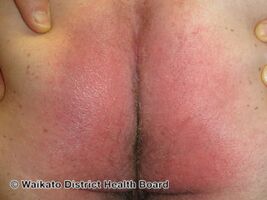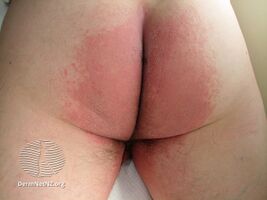Baboon syndrome
| Baboon syndrome | |
|---|---|
| Specialty | Dermatology |
Symmetrical drug-related intertriginous and flexural exanthema (SDRIFE), more popularly known as Baboon syndrome because of its resemblance to the distinctive red buttocks displayed by female baboons, is a systemic contact dermatitis characterized by well-demarcated patches of erythema distributed symmetrically on the buttocks.[1] The cause of the syndrome may be drug-related, i.e. induced by systemic administration of hydroxyzine[2] penicillin,[3] iodinated radio contrast media[4] and others.
Symptoms and signs
The typical rash commonly appears on buttocks. This then resembles the colour of a baboon's buttocks. Other areas like upper inner thigh and armpits, may be affected by the rash. The rashes are red and well-defined. The presentation is typically symmetrical and not associated with systemic symptoms.[5]
-
Baboon syndrome
-
Baboon syndrome
Diagnosis
This section is empty. You can help by adding to it. (April 2017) |
Treatment
Treatment of symmetrical drug related intertriginous and flexural exanthema involves identifying and stopping the causative agent. Topical steroids can help to reduce the redness.[6]
Epidemiology
Baboon syndrome affects both sexes equally, and can occur at any age, but seems to be more common in childhood than in adulthood.[7]
See also
References
- ↑ Rapini, Ronald P.; Bolognia, Jean L.; Jorizzo, Joseph L. (2007). Dermatology: 2-Volume Set. St. Louis: Mosby. ISBN 978-1-4160-2999-1.
- ↑ Akkari, H.; Belhadjali, H.; Youssef, M.; Mokni, S.; Zili, J. (May 2013). "Baboon syndrome induced by hydroxyzine". Indian J Dermatol. 58 (3): 244. doi:10.4103/0019-5154.110871. PMC 3667318. PMID 23723506.
- ↑ Handisurya, A.; Stingl, G.; Wöhrl, S. (Apr 2009). "SDRIFE (baboon syndrome) induced by penicillin". Clin Exp Dermatol. 34 (3): 355–7. doi:10.1111/j.1365-2230.2008.02911.x. PMID 18699835.
- ↑ Arnold, AW.; Hausermann, P.; Bach, S.; Bircher, AJ. (2007). "Recurrent flexural exanthema (SDRIFE or baboon syndrome) after administration of two different iodinated radio contrast media". Dermatology. 214 (1): 89–93. doi:10.1159/000096920. PMID 17191055.
- ↑ Utaş, S.; Ferahbaş, A. (2009). "Baboon syndrome and segmental vitiligo coexistence". The Turkish Journal of Pediatrics. 51 (4): 392–4. PMID 19950853.
- ↑ "Symmetrical drug related intertriginous and flexural exanthema | DermNet NZ". www.dermnetnz.org. Archived from the original on 2019-04-17. Retrieved 2019-04-19.
- ↑ Moreno-Ramírez, D.; García-Bravo, B.; Pichardo, AR.; Rubio, FP.; Martínez, FC. (2004). "Baboon syndrome in childhood: easy to avoid, easy to diagnose, but the problem continues". Pediatr Dermatol. 21 (3): 250–3. doi:10.1111/j.0736-8046.2004.21313.x. PMID 15165206.
- Pages with script errors
- Articles to be expanded from April 2017
- Articles with invalid date parameter in template
- All articles to be expanded
- Articles with empty sections from April 2017
- All articles with empty sections
- Articles using small message boxes
- Contact dermatitis
- Syndromes affecting the skin
- All stub articles
- Dermatology stubs

